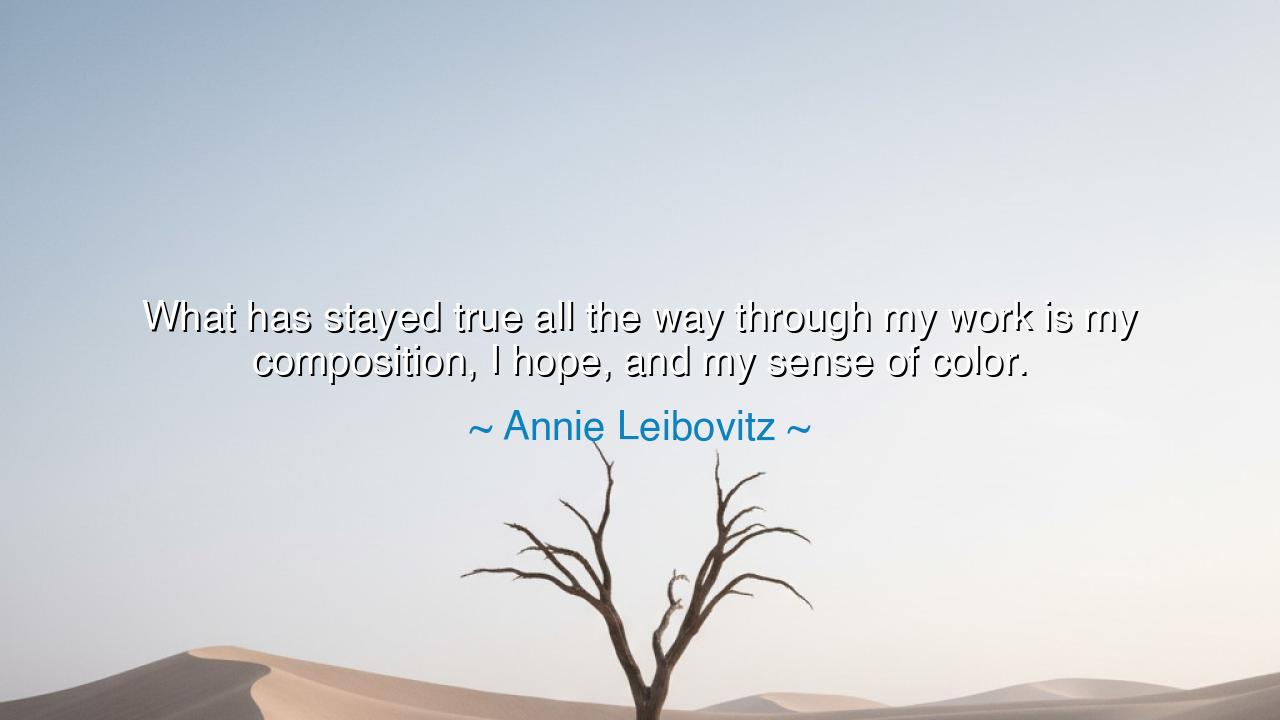
What has stayed true all the way through my work is my
What has stayed true all the way through my work is my composition, I hope, and my sense of color.






In the halls where images are weighed like gold, hear Annie Leibovitz speak with the calm of a master: “What has stayed true all the way through my work is my composition, I hope, and my sense of color.” In one breath she names the pillars of her art—composition as the architecture of meaning, color as the weather of feeling, and hope as the moral that steadies the hands. The years may alter cameras and clients, but the eye that orders a frame and the heart that chooses a hue remain the artist’s covenant with herself.
The meaning is flint-bright. To claim composition is to bow to structure—the way lines and bodies converse, the way a gesture earns its space, the way silence inside a picture speaks. To claim a sense of color is to confess that tones are not decoration but narrative—how green can brood, how skin can sing, how a red coat can carry the weight of a story across a crowded field. And to add “I hope” is humility in its proper place: even at the summit, a great maker knows the work must answer for itself.
This credo threads through Leibovitz’s long journey—from the restless reportage of Rolling Stone to the theatrical tableaux of Vanity Fair and Vogue. Across those decades she has said, again and again, that technique serves vision and that vision matures without abandoning its roots. When she speaks publicly about her craft, she returns to these constants: the discipline of arranging a scene, the responsibility of color, the refusal to let fashion swallow story. The tools shift; the spine does not.
A story makes the lesson plain. On the morning of December 8, 1980, she arranged John Lennon and Yoko Ono in a tender knot—his unclothed body curved around her clothed form, a composition of contrasts and devotion. The photograph became an elegy within hours. It endures not for scandal but for its ordering: the oval of two heads, the diagonal of limbs, the palette muted to let skin and denim speak. Here composition holds grief without spilling it; color whispers instead of shouts. The picture is theater and truth at once, proof that when the frame is right, the moment can carry centuries. (Her broader career accounts confirm this steady devotion to structure and tone.)
Even in technical talk her devotion to color reveals an ethic: she has noted how greens once misbehaved on film, how she adjusted palettes to keep foliage from swallowing faces, how a touch of yellow could rescue a scene from dullness. These are not tricks; they are mercies—choices that protect the subject’s humanity from the camera’s cruelties. The ancient teachers would say: art is stewardship. In Leibovitz’s studio, color is not a veil but a vow.
Consider a humbler parable from a small-town theater. A young photographer, dazzled by gear, cluttered the stage with lights and props. An older mentor removed two stands, closed a backdrop, and asked, “Where does your composition want me to look?” The student shifted a chair, cooled a gel, and watched as the actor’s face became the sun of the room. The audience later said the portrait “felt true.” What changed was not budget but belief: the frame learned to tell a single story, and color learned to serve it.
From this quotation a rule of life emerges for any maker. First, honor composition: before you add, arrange. Ask what belongs and what merely distracts; let lines guide the gaze as rivers guide boats. Second, treat color as meaning: choose palettes that carry feeling instead of decorating it; study how light and skin converse; keep notes on tones that betray you. Third, keep a craftsman’s hope: return to your constants when trends clamor—your eye, your ethic, your patient way of placing one thing next to another until it sings.
Carry her cadence like a pocket prayer: stayed true, work, composition, sense of color, hope. Let it steady your hand when fashion hurries you and praise attempts to scatter you. For the ancients teach, and Leibovitz confirms: style without structure is noise; hue without honor is gloss. Build your frame. Choose your tones. Keep your hope. And if you are faithful to these small, exacting vows, your pictures—like hers—will outlast their moment and become part of the memory by which an age knows itself.






AAdministratorAdministrator
Welcome, honored guests. Please leave a comment, we will respond soon